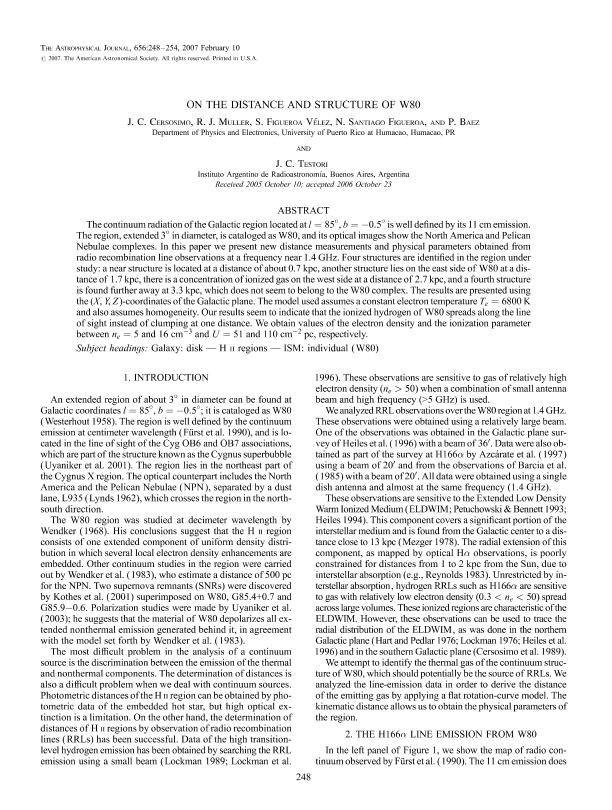Mostrar el registro sencillo del ítem
dc.contributor.author
Cersósimo, Juan Carlos
dc.contributor.author
Muller, R. J.
dc.contributor.author
Figueroa Vélez, S.
dc.contributor.author
Santiago Figueroa, N.
dc.contributor.author
Baez, P.
dc.contributor.author
Testori, Juan Carlos

dc.date.available
2017-08-14T19:20:37Z
dc.date.issued
2007-12
dc.identifier.citation
Cersósimo, Juan Carlos; Muller, R. J.; Figueroa Vélez, S.; Santiago Figueroa, N.; Baez, P.; et al.; On the distance and structure of W80; Iop Publishing; Astrophysical Journal; 656; 1; 12-2007; 248-254
dc.identifier.issn
0004-637X
dc.identifier.uri
http://hdl.handle.net/11336/22324
dc.description.abstract
The continuum radiation of the Galactic region located at l = 85°, b = -0.5° is well defined by its 11 cm emission. The region, extended 3° in diameter, is cataloged as W80, and its optical images show the North America and Pelican Nebulae complexes. In this paper we present new distance measurements and physical parameters obtained from radio recombination line observations at a frequency near 1.4 GHz. Four structures are identified in the region under study: a near structure is located at a distance of about 0.7 kpc, another structure lies on the east side of W80 at a distance of 1.7 kpc, there is a concentration of ionized gas on the west side at a distance of 2.7 kpc, and a fourth structure is found further away at 3.3 kpc, which does not seem to belong to the W80 complex. The results are presented using the (X, Y, Z)-coordinates of the Galactic plane. The model used assumes a constant electron temperature Te = 6800 K and also assumes homogeneity. Our results seem to indicate that the ionized hydrogen of W80 spreads along the line of sight instead of clumping at one distance. We obtain values of the electron density and the ionization parameter between ne = 5 and 16 cm-3 and U = 51 and 110 cm-2 pc, respectively.
dc.format
application/pdf
dc.language.iso
eng
dc.publisher
Iop Publishing

dc.rights
info:eu-repo/semantics/openAccess
dc.rights.uri
https://creativecommons.org/licenses/by-nc-sa/2.5/ar/
dc.subject
Radio Continuum
dc.subject
Hii Regions
dc.subject
Interstellar Medium
dc.subject
W80 (Estrella)
dc.subject.classification
Otras Ciencias Físicas

dc.subject.classification
Ciencias Físicas

dc.subject.classification
CIENCIAS NATURALES Y EXACTAS

dc.title
On the distance and structure of W80
dc.type
info:eu-repo/semantics/article
dc.type
info:ar-repo/semantics/artículo
dc.type
info:eu-repo/semantics/publishedVersion
dc.date.updated
2017-05-18T21:20:33Z
dc.journal.volume
656
dc.journal.number
1
dc.journal.pagination
248-254
dc.journal.pais
Estados Unidos

dc.description.fil
Fil: Cersósimo, Juan Carlos. Universidad de Puerto Rico; Puerto Rico
dc.description.fil
Fil: Muller, R. J.. Universidad de Puerto Rico; Puerto Rico
dc.description.fil
Fil: Figueroa Vélez, S.. Universidad de Puerto Rico; Puerto Rico
dc.description.fil
Fil: Santiago Figueroa, N.. Universidad de Puerto Rico; Puerto Rico
dc.description.fil
Fil: Baez, P.. Universidad de Puerto Rico; Puerto Rico
dc.description.fil
Fil: Testori, Juan Carlos. Provincia de Buenos Aires. Gobernación. Comision de Investigaciones Científicas. Instituto Argentino de Radioastronomía. Consejo Nacional de Investigaciones Científicas y Técnicas. Centro Científico Tecnológico Conicet - La Plata. Instituto Argentino de Radioastronomia; Argentina
dc.journal.title
Astrophysical Journal

dc.relation.alternativeid
info:eu-repo/semantics/altIdentifier/url/http://adsabs.harvard.edu/abs/2007ApJ...656..248C
dc.relation.alternativeid
info:eu-repo/semantics/altIdentifier/url/http://iopscience.iop.org/article/10.1086/510372/meta
dc.relation.alternativeid
info:eu-repo/semantics/altIdentifier/doi/http://dx.doi.org/10.1086/510372
Archivos asociados
